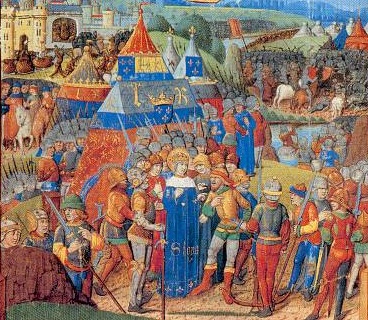Trencavel, son of the dispossessed Viscount of Carcassone and Beziers, appeared in southern France in 1240 with a troop of Aragonese mercenaries and captured several fortresses. The invaders then moved against Carcassone and through the connivance of supporters occupied the commercial district outside the walls from where they besieged the old town on the heights. Thirty-three priests who were unable to reach safety were treacherously massacred. [Louis IX] sent a royal army that relieved the threatened town and destroyed the rebel troop and the property of the collaborators. Trencavel and his more powerful leaders fled back to Aragon or to their mountain strongholds.

Henry III of England
Two years later all the discontented barons in Poitou, Gascony, and Languedoc rose up in rebellion under the leadership of the English King Henry III and Raymond VII. The disgruntled lords deeply resented the investment of Alphonse of Poitiers, one of the King’s brothers, as Count of Poitou and his marriage to the daughter of Raymond who was poised to inherit the county of Toulouse. Louis, invaded Poitou, a land full of castles held by rebels. One by one the castles fell.

As the inexorable machine rolled on, many nobles abandoned the rebel cause and made peace with the King. Louis caught up with the English soldiers outside the town of Saintes and easily defeated them. Raymond, seeing himself out on a limb, with many of his allies defecting, also capitulated. Louis who had personally led his army in the field had given a good account of himself as a warrior and tactician and, from that time on, without any hindrance from rebellious nobles, had the opportunity to administer his land in justice and peace.
Jeremias Wells, History of Western Civilization (n.p., n.d), pp. 265-266.
Short Stories on Honor, Chivalry, and the World of Nobility—no. 70









